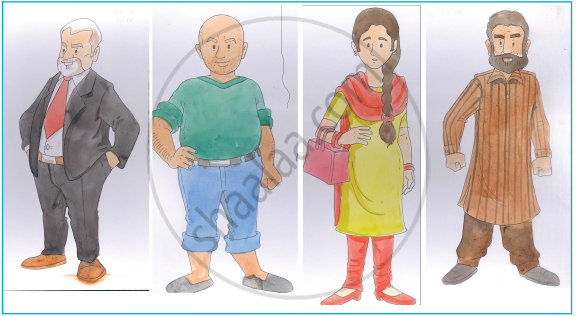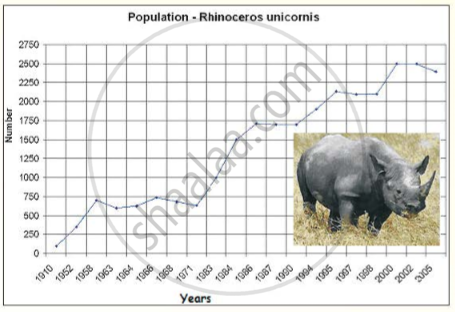Advertisements
Advertisements
प्रश्न
When does the kite seem to take rest?
उत्तर
The kite seems to take rest as the wind falls.
APPEARS IN
संबंधित प्रश्न
Do you like rain? What do you do when it rains steadily or heavily as described in the poem?
“Toto was a pretty monkey.” In what sense is Toto pretty?
Lushkoff is earning thirty five roubles a month. How is he obliged to Sergei for this?
Answer the following question in one or two sentences.
What do you think Dinamani is the name of? Give a reason for your answer.
We notice lots of details about people and their appearance, but in order to
vividly describe them , we need to be specific.
Working in pairs, look carefully at the people around you and complete the
table with appropriate words from the box given on the next page. You may
add words of your own to describe people.

| angular | close-cropped | well-tailored | well-tailored casual | stocky |
| elegant | unshaven | ill-fitting | formal | lanky |
| bearded | sloppy | medium | petite | hefty |
| balding | slim | plaited | thick | round |
| open | friendly | wavy | long | receding |
| over weight | sharp-featured |
| A | B | C | D | |
| Face | ||||
| Hair | ||||
| Dress | ||||
| Build |
Read this article about the great Indian Rhinoceros. [You will find the information useful for your group discussion in 5.]
The Indian Rhinoceros or the Great One-Horned Rhinoceros or the Asian Onehorned Rhinoceros (Rhinoceros unicomis) is a large mammal primarily found in north-eastern India, Nepal and parts of Bhutan. It is confined to the tall grasslands and forests in the foothills of the Himalayas.
The Indian Rhinoceros once ranged throughout the entire stretch of the Indo Gangetic Plain but excessive hunting reduced their natural habitat drastically.
Today, about 3,000 Indian Rhinos live in the wild, 1,800 of which are found in Assam alone. In 2008, more than 400 Indian Rhinos were sighted in Nepal's Chitwan National Park.
In size it is equal to that of the White Rhino in Africa; together they are the largest of all rhino species. The Great One-Horned Rhinoceros has a single horn; this is present in both males and females, but not on newborn young. In most adults, the horn reachee a length of about 25 centimetres, but has been recorded up to 57 .2 centimetres in length. The nasal hom curves backwards from the nose. The horn is naturally black.
This prehistoric-looking rhinoceros bas thick, silver-brown skin which becomes pinkish near the large skin folds that cover its body. The male develops thick neckfolds. It has very little body hair aside from eyelashes, ear-fringes and tail-brush.
These rhinos live in tall grasslands and riverine forests, but due to the loss of habitat, they have been forced towards cultivated land. They are mostly solitary creatures, with the exception of mothers and calves and breeding pairs, although they sometimes, congregate at bathing areas.

The Indian Rhinoceros makes a wide variety of vocalizations. At least ten distinct vocalizations have been identified: snorting, honking, bleating, roaring, squeak panting, moo-grunting, shrieking, groaning, rumbling and humphing. In addition to noises, the rhino also uses olfactory communication.
In aggregation, Indian Rhinos are often friendly. They will often greet each other by waving or bobbing their heads, mounting flanks, nuzzling noses, or licking. Rhinos will playfully spar, run around, and play with twigs in their mouth. Adult males are the primary instigators of fights. Fights between dominant males are the most common cause of rhino mortality. Indian rhinos have few natural enemies, except for tigers. Tigers sometimes kill unguarded calves, but adult rhinos are less vulnerable due to their size. Humans are the only other animal threat, hunting the rhinoceros primarily for sport or for the use of its horn. Indian Rhinos have been somewhat tamed and trained in circuses, but they remain dangerous and unpredictable animals.
In the nineteenth and early twentieth century, the Indian Rhinoceros was hunted relentlessly. Reports from the middle of the nineteenth century claim that some military officers in Assam individually shot more than 200 rhinos. In the early 1900s, officials became concerned at the rhinos' plummeting numbers. By 1908 in Kaziranga, one of the Rhinos' main ranges, the population had fallen to around 12 individuals. In 1910, all rhino hunting in India became prohibited.
The rhino has been a major success in conservation. Only 100 remained in the early 1900s; a century later, their population has increased to about 2500 again, but even so, the species is still endangered. The Indian rhino is illegally poached for its horn. Some cultures in East Asia believe that the hair has healing and potency powers and therefore is used for traditional Chinese medicine and other Oriental medicines.
The Indian and Nepalese Governments have taken major steps towards Indian Rhinoceros conservation with the help of the World Wildlife Fund (WWF). The Kaziranga National Park and Manas National Park in Assam, Pobitora Reserve Forest in Assam {having the highest Indian rhino density in the world), Orang National Park of Assam, Laokhowa Reserve Forest of Assam (having a very small population) and Royal Chitwan National Park in Nepal are homes to this endangered animal.
More complex Connectors
Read through the following text. Pay special attention to the underlined words. These help the reader to understand the relationship between sentences, or the parts of sentences, clearly.
Select as many appropriate words as possible from the list given below to replace the underlined words. Be careful not to change the basic meaning too much.
| to his amazement | even though |
| although | in actual fact |
| as a matter of fact | lastly |
| generally | usually |
| however | nevertheless |
| besides | to his surprise |
| asarule | all the same. |
Martin’s Picture
Margin wasn’t a very bright boy. Normally, he never came more than second from the bottom in any test. But, that morning in the art lesson, he had drawn a beautiful picture of a scarecrow in a field of yellow corn. To his astonishment, the drawing was the only one given full marks – ten out of ten – which made him for the first time in his life the best in the class! He had proudly pinned the picture up on the wall behind his desk, where it could be admired by all. It seemed though, that not everyone admired it. Some unknown member of the class had, in fact, taken a violent dislike to it.
During the lunch break, when the classroom had been deserted, the picture had been torn off the wall. Moreover, it had been trodden or stamped on. As if that wasn’t enough, the words ‘ROTTEN RUBBISH’ had been written on the back in big round letters. And finally, the paper was so creased that it looked as though it had been screwed up into a tight ball and perhaps thrown about the room.
“Who could have done it?” Martin wondered.
Now rewrite the text.
Martin’s picture
Martin wasn’t a very bright boy.
Usually,
Generally
As a rule, He never came more than second from the bottom in any test.
However,…. ______________________
Read the following passage on New Zealand.
New Zealand is a Mecca for nature lovers. Throughout most of New Zealand's geological history, it was a bird's paradise. The islands were once part of the southern super - continent Gondwana from which they broke off around 80 million years ago before mammals had evolved and spread.
(courtesy: Terra Green Sept 2008 issue 06)
The underlined words express a relationship usually of space or time between the words with which they stand. Such 'Positional' words which are used before nouns (pre-position) are called prepositions.

Some are Purple and gold flecked grey
For she who has journeyed through life midway,
Whose hands have cherished , whose love has blest,
And cradled fair sons on her faithful breast,
And serves her household in fruitful pride,
And worship the gods at her husband's side.
Read the lines given above and answer the question that follow:
What fulfills the life of an Indian wife and mother?
Abou Ben Adhem (may his tribe increase!)
Awoke one night from a deep dream of peace,
And saw, within the moonlight in his room,
Making it rich, and like a lily in bloom,
An angel writing in a book of gold:-
Read the lines given above and answer the following question.
What was the angel doing when Abou bin Adhem saw him within the moonlight in his room?
The boy looked up. He took his hands from his face and looked up at his teacher. The light from Mr. Oliver’s torch fell on the boy’s face, if you could call it a face. He had no eyes, ears, nose or mouth. It was just a round smooth head with a school cap on top of it.
And that’s where the story should end, as indeed it has for several people who have had similar experiences and dropped dead of inexplicable heart attacks. But for Mr. Oliver, it did not end there. The torch fell from his trembling hand. He turned and scrambled down the path, running blindly through the trees and calling for help. He was still running towards the school buildings when he saw a lantern swinging in the middle of the path. Mr. Oliver had never before been so pleased to see the night watchman. He stumbled up to the watchman, gasping for breath and speaking incoherently.
What is it, Sahib? Asked the watchman, has there been an accident? Why are you running?
I saw something, something horrible, a boy weeping in the forest and he had no face.
No face, Sahib?
No eyes, no nose, mouth, nothing.
Do you mean it was like this, Sahib? asked the watchman, and raised the lamp to his own face. The watchman had no eyes, no ears, no features at all, not even an eyebrow. The wind blew the lamp out and Mr. Oliver had his heart attack.
Read the extract given below and answer the question that follow.
Why did Mr Oliver tell the boy that he should not be out at that hour?
Did the wise men win the reward? If not, why not?
Why did he ask for the king’s forgiveness?
Why did Abbu Khan laugh with joy?
Multiple Choice Question:
What does the expression “They pinched the chocolate-flakes’ mean?
The Streetlamp has been compared to a _____.
The lane is dark and lonely because __________.
Can there be a good reason behind speaking when everybody else is silent?
How old was Margot when she first arrived on his distant planet?
What special ‘deed of gift’ does Jessica give to Lorenzo at the end of the play?
